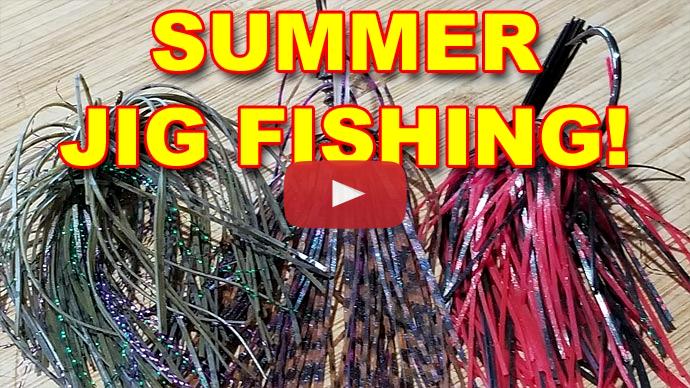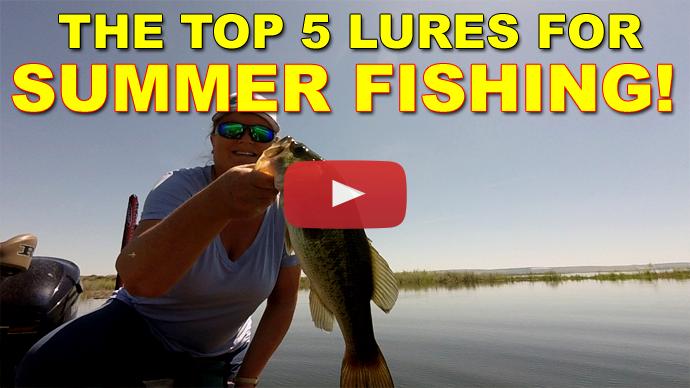Hi, I'm Jeremy Lawer and I'm here with BassResource and I want to talk you a little bit about fishing in the summertime. You know, the summertime is a great time to really find a school of bass. You know and one technique that we always use around the country is throwing a jig into a school of fish on a piece of structure, or a channel swing, or a current break, whatever it might be.
You know, what's happened is the fish have spawned, the water's gotten warm, everything's over with and now they've just moved out there to recuperate and they're going to be there for a while too. So it seems like there are starting to be more groups of fish, larger groups of fish, more numbers. It's a way to really have a lot of fun. It takes a little while to find a fish sometimes, but once you do, you can really make hay in a hurry and have a lot of cast action quick.
But one technique I really like to use doing that is throwing a jig. You know, this is going to be more of your structure style jig rather than that flipping style because we're going to be fishing that 15 to 25, 30-foot of water depending on where you're from. And you can see there the head design's kind of a semi between a football jig and a flipping jig. It's gonna be more of a structure-style jig.
Now, this jig's a little heavier too. This is a 5/8 ounce. I like to throw a jig that really has a nice action but it's going to have a nice fall rate as well. A lot of times when you stroke that jig up or if you just kind of get up there to where they're at and in you're in the rubble and you kind of hop it up out of there, it makes a quick hop. A lot of times that gets that reaction bite. So I like to go with the heavier jig.
Another reason for using a heavier jig is I always like to go with big line. You know I like to throw out there with a 20-pound Shooter Sunline fluorocarbon. You know, a lot of guys will use Sniper and other brands and that's perfectly fine.
Shooter's a little bit stiffer. I think I stay in contact with the bait more. And I think with that heavier jig, it allows me to use that heavier, more abrasive line like Shooter is. And I want to put all those advantages in my corner and I feel like that does it doing that.
Another thing I'm gonna do is I'm gonna use a bigger trailer. And you can see here this is a big flapping trailer. You know, that's a big bait right there in your hand but they're keying on big crawdads, big perch, big gizzards, shad. You know, summer's here and they're really eating it up, you know. And so a larger bait really kind of takes away from getting so many little bites in those schools as well because it's kind of like duck hunting. You leave a few ducks there and a few more come and few more come, over time you've got a hundred ducks setting there but some of them are little ducks, some of them are ducks you're not even allowed to shoot.
There's just different ways. A school of fish is no different. You've got all these different mixtures and a larger bait allows me to key in on the biggest largemouth, the biggest spotted bass. So it just depends on what your quarry might be and the way you're trying to fish.
If you're wanting to fish and just have a good time for the day, a lot of times you can have a little bitty jig there with it and a heavy weight like this, like a 3/4-ounce football jig but with a small trailer. And after you turn around and catch the biggest ones out of the school and kind of slow down with things going on, switch to that smaller jig. But most of the time as a tournament angler, once we start catching the smallest ones or the school slows down, we just move on to another school. But it's a really great way to absolutely just have a ball, catch a big bag of fish, try and win a tournament. It's a summertime pattern.
Now, in the Ozarks we don't have any grass but we've got a lot of brush piles. We sink a lot of brush piles. We flip a lot of boat docks. We fish a lot of structure that's manmade, possibly a dock is sunken. And you know, a lot of jigs won't come through that. But around home that we figured out that a punch-style jig will absolutely come through that better than any weed guard style jig that I've found. You know, this is a half-ounce Tungsten punch weight just like you'd punch in Florida with for vegetation or anything, but it works really, really good around wood, brush piles.
You know, you can get these in 1/8 ounce or 3/16 ounce, put them up to an ounce-and-a-half, almost 2-ounce, I think. But normally a half-ounce or a 3/4-ounce, you put your skirt on there like that, you always want to use a straight shank hook and snell knot it so that way it kicks over whenever you do get that bite. You know, you can see there it really stands over there and tries to catch that fish in the corner of the mouth.
But what this really does is when it comes up to a V of a limb, it's just going to, I mean, aerodynamically just shoot right through it. And if you can kind of start feeling your way up there to it and as you get to it, hop at that last 4 or 5 inches and make it hit that limb hard and kind of jump off the ledge. And that's a really great way to trigger a strike. But when you do that so many times with your standard weed guard-type jig, it hangs on you and then you've just kind of lost that moment, and then when you break it off or you gotta go get it. So a punch jig is a really good arsenal that I've kind of added, you know, in an area where we don't have grass. So don't be afraid to kind of think outside the box and do that.
But both of these setups I'm still going to throw on that 7'6" Denali Lithium rod, still with the high-speed reel. Now, I do like to throw a 25-pound Sunline Shooter on this application as well. The braid is a little bit worrisome about digging into the tree bark, digging into zebra mussels.
And you would think with having a bunch of zebra mussels in the Ozarks that the braid would work better around it and it actually doesn't. The zebra mussel will actually cut this 50-pound braid quicker than it will 25-pound fluorocarbon.
And so it's just kind of a different approach. You can use it on the same type situations but it really gives you a totally different action. You might have way better percentages of getting your bait presented to the bass.
And it's just another way that they haven't seen it. It looks a little bit more finesse-y too in the water. That skirt really folds tight. You know, you can see there it really folds tight next to that bait. And it's just kind of a finesse-y jig approach but it's a great way to catch them in the summertime. It's a great way to catch them out of structure. And it's just one of those things that I'm so glad that I've kind of added to my arsenal because it definitely has put more fish in my boat and more money in my pocket. So be sure and check these two out. If you're going to fish anywhere in the summertime, it's a must-have.



